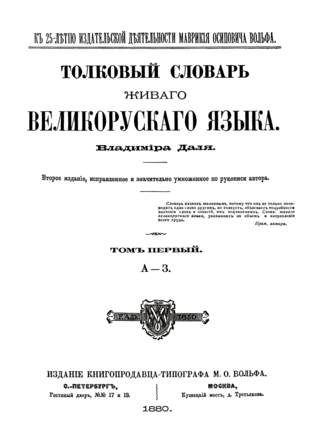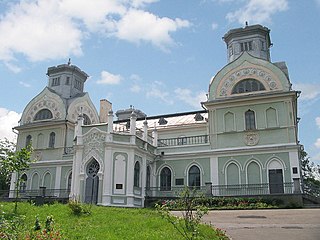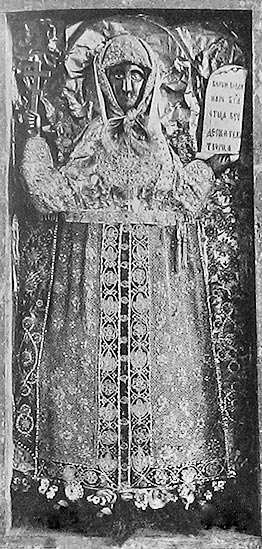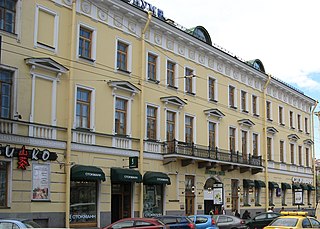
Mat is the term for vulgar, obscene, or profane language in Russian and some other Slavic language communities. The term mat derives from the Russian word for mother, a component of the key phrase "Ёб твою мать", "yob tvoyu mat'".
Oleg Nikolayevich Trubachyov was a Soviet and Russian linguist. A researcher of the etymology of Slavic languages and Slavic onomastics, specialist in historical linguistics and lexicographer. He was a Doctor of Sciences in Philological Sciences, an academician of the Russian Academy of Sciences and served as the editor-in-chief of the Etimologiya yearbook. His works are on the etymology of Slavic languages and on East Slavic onomastics.

The Explanatory Dictionary of the Living Great Russian Language, commonly known as Dal's Explanatory Dictionary, is a major explanatory dictionary of the Russian language. It contains about 220,000 words and 30,000 proverbs. It was collected, edited and published by academician Vladimir Ivanovich Dal, one of the most prominent Russian language lexicographers and folklore collectors of the 19th century.

The Etymological Dictionary of Slavic Languages: Proto-Slavic Lexical Stock is an etymological dictionary of the reconstructed Proto-Slavic lexicon. It has been continuously published since 1974 until present, in 43 volumes, making it one of the most comprehensive in the world.

Tatiana Valerianovna Dorofeeva was a Russian linguist, orientalist and translator.

Rus' chronicle or Russian chronicle or Rus' letopis is the main type of Rus' historical literature. Chronicles were composed from 11th to 18th centuries. Chronicles were one of the leading genres of Old Rus' literature.

The Lopukhin family was a noble family of the Russian Empire, forming one of the branches of the Sorokoumov-Glebov family.
Praskovia Naumovna Arian, née Belenkaia, was a Russian writer, translator, feminist and educator. She founded the annual First Women's Calendar covering women's issues in Russia and later the First Women’s Technical Institute. She wrote articles under the pseudonym "Ar.". In the 1930s she taught courses for workers at the Kirov Plant in Leningrad.

Mikhail Hryhorovych Krivoshlyk, was a Russian Journalist, Writer, editor-publisher and State Councillor.

Yakov Yakovlevich Brandt was a Russian sinologist, diplomat, linguist and professor.
Fedor Davidovich Kapelyush, was a Russian engineer, economist, writer, Marxist, and translator.
The Shardak is a river in the Tatyshlinsky District of Bashkortostan, in Russia; it flows into the river Yug. It flows past the villages Old Shardak and New Shardak.
Anatoly Vasilyevich Belov was a Soviet religion scholar and atheist propagandist. He was a First Deputy Chairman of the Council for Religious Affairs under the Council of Ministers of the USSR, an expert on Adventism and one of the authors of the Atheistic Dictionary and Atheist Handbook.
Konstantin Vasilyevich Dushenko is a Russian translator, culturologist and historian. His with the Institute of Scientific Information on Social Sciences of the Russian Academy of Sciences. He authored over 30 books on the origins of various quotations, aphorisms, and bon mots.

The Fyappiy, exonym: Kists/Nearby Kists—an Ingush society. The centre of the society was the aul of Metskhal, after which it was simultaneously called Metskhalin society and the inhabitants Metskhalins in the 2nd half of the 19th century. The region of historical settlement of Fyappiy was Fyappiy Mokhk.

Paraskeva Friday is an image based on a personification of Friday as the day of the week and the cult of saints Paraskeva of Iconium, called Friday and Paraskeva of Serbia. In folk tradition, the image of Paraskeva Friday correlates with the image of Goddess, Saint Anastasia of the Lady of Sorrows, and the Week as a personified image of Sunday.

The Nut Feast of the Saviour is the third spas feast of the Saviour which celebrates the Holy Mandylion of the Lord. It is celebrated as the afterfeast of the solemnity of the Dormition. After the Honey Feast of the Saviour and the Apple Feast of the Saviour, the Nut feast is therefore placed on August 16 in the Julian calendar and on August 29 in the Gregorian calendar.

Kazan Cathedral House, also widely known as the house of the clergy of the Kazan Cathedral, is a historic building in Saint Petersburg, Russia. The building was built in 1813-1817 in the style of Russian Neoclassicism. Architects—Vasily Stasov, Andrey Voronikhin. Before the Russian Revolution, the house belonged to the clergy of the Kazan Cathedral . Location: St. Petersburg, Nevsky Prospect, 25 & Kazanskaya street, 1. Regional object of cultural heritage.
Siberian dialects are a group of Northern Russian dialects under the serious lexical influence of the South Russian dialects and foreign inclusions. It is spoken by Siberian old-timers: Siberiaks, Chaldons, Kerzhaks, Cossacks, Old Believers, Pokhodchans (Kolymchans), Russian Ustians (Indigirshchiks), and Markovites (Anadyrshchiks).
Ethnonyms of the Ingush — names of Ingush people, including self-names (endonyms) and names used by other ethnic groups to refer to the Ingush (exonyms) throughout the existence of Ingush people from Middle Ages to the modern day.











